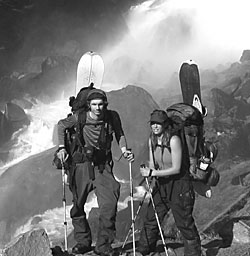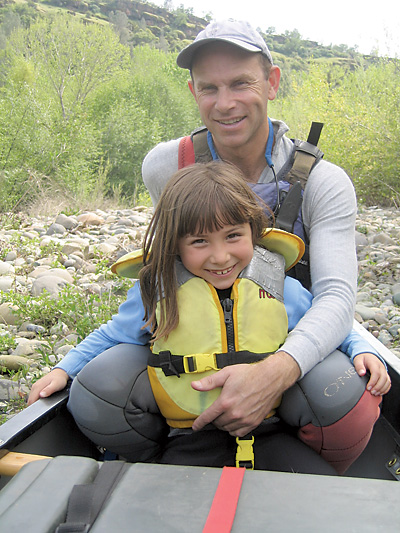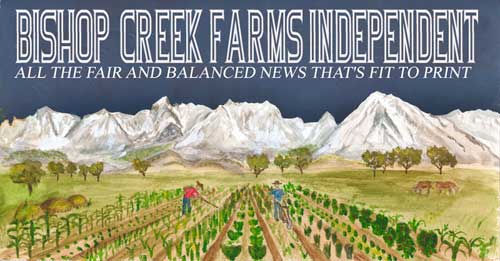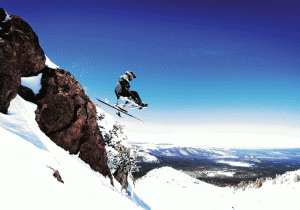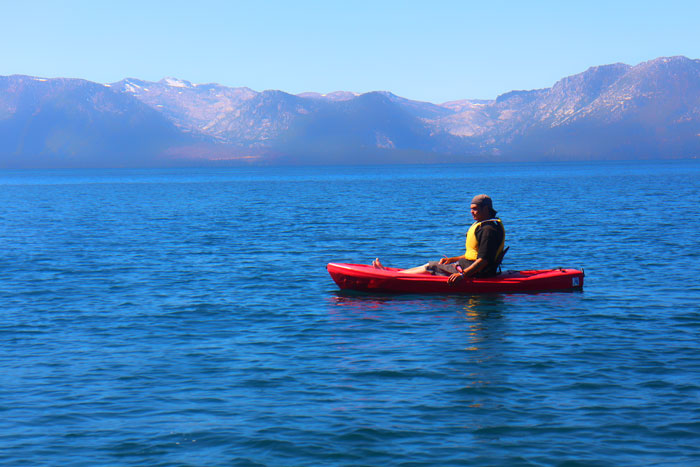- Tahoe’s Nevada Beach Tops the List of Hard-to-Book Campgrounds - 07/17/2024
- Cannabis Watershed Protection Program Cleans Up Illegal Grow Sites - 07/10/2024
- French Fire - 07/05/2024
Story by Seth Lightcap
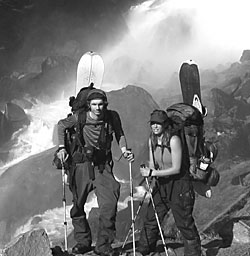
Photo: Steve Borge
There is a fine line between passion and addiction. Passion connotes a ravenous love, often at the edge of control. Addiction suggests a habitual fixation, usually beyond control. So then, how does one define a love so wildly passionate that your soul abandons all control and drowns in pleasure regardless of sacrifice?
Twenty four months into an ongoing quest to backcountry snowboard every month of the year, my relationship with snowy peaks, scoured ridges and epic drives demands such a cross-examination.
Floating knee-deep turns… Taking flight off cornices… Bonking powder laden trees… Surely passion!
But driving 10 hours round trip from Santa Cruz for every outing… Hiking for hours in loose talus for a 100-yard patch of sun cupped, barely edgeable snow… Addiction?
It’s just something about snow. Powder, slush, wind buff, even breakable crust. I need it. Got to have it. When? Now! Pack the boards, grab the boots, and pick me up. We’re going snowboarding. But it’s August! Fine. Bring some flip-flops for the approach.
Thankfully, I am not alone in my fiendish pursuit. As the northern hemisphere barrels headlong into winter it marks the second complete year that my equally passionate partner, Allison Lipp, and I have fulfilled our craving for an endless winter in the high peaks of the Sierra and Cascades.
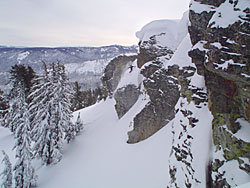
Beyond Bounds Training Photo: Brian Bozack
The concept of skiing or riding year round is not a new one. A Pacific Northwest forum called Turns-All-Year.com boasts over 500 members. One skier in Colorado just celebrated his 300th consecutive month of skiing. But we don’t live in Whistler, B.C. or Leadville, Colorado.
Living on the California coast, our quest to snowboard year round has been a daunting test of backcountry strategy. The snow pack evolves so quickly that sometimes we haven’t decided where to go and the car is already packed and running. Should we go to the eastside of Mt. Shasta or hunt for snowfields on Sonora Pass? Should we guarantee success and drive to Mt. Hood? Will it all be bullet proof ice when we get there? Maybe.
In concept, our monthly ritual seems simple… find the best snow conditions possible to hike and snowboard at least 1,000 vertical feet. In the leanest of snow months, we’ll settle for riding at least ten linked turns.
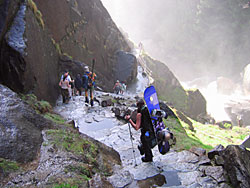
Approaching Sierra gridlock on the Mist Trail, Yosemite.
Photo: Seth Lightcap
Somehow we have managed to pull it off without strangling each other in a Milpitas traffic jam or a loose talus field, but we’ve been close a few months. The sight of snow and the satisfaction of knowing you’ve
completed yet another improbable outing always reunites us.
Our fixation might seem trivial or misguided to the uninitiated masses, but those who have felt the burn and bliss of earning your turns are better able to understand why we stretch our every resource to play this game. When every adventure involves keen exploration, rugged exercise, and the adrenaline rush of backcountry snowboarding, it’s easy to get addicted.
Here’s to a hearty winter and a bountiful harvest come next summer.
Twelve Months of Snow: The Cali Reality
January
“Ski Dreams”Matterhorn Peak • Bridgeport, CA
“Ski Dreams” is a broad but steep ramp cresting the ridge just east of the summit of Matterhorn Peak. Typically tackled in two or three days, the snowfield funnels slightly and then dumps into a massive bowl ringed on all sides by spectacular towers. When filled with milky powder, a descent of “Ski Dreams” is a true wet dream.
February
“Bear Scratch”• East Shore, Lake Tahoe
The “Bear Scratch” is the name for the steep logging flumes that plummet off of Marlett Peak high above Incline Village. East shore descents require a low snow line, so tackle this one after a heaping
helping of snow at lake level. Expect steep technical lines entering the namesake chutes and moderate tree glades along nearby ridges.
March
Sugar Bowl to Squaw Valley
Here’s a fabulous warmup for a big spring tour. The recommended route meanders along the Sierra Crest from the top of Mt. Lincoln at Sugar Bowl to Shirley Canyon at Squaw. Wicked descents of Anderson Peak and Tinkers Knob highlight a moderate tour that even has two Sierra Club huts perfectly positioned along the way. Reservations required.
April
Mammoth to Yosemite Valley
April usually marks the height of the winter snow pack in the Sierra. Go Big. Cross the Sierra Crest and don’t look back. Last year, we splitboarded the John Muir Trail from Mammoth Mountain to Yosemite Valley, nearly 60 miles, with summit descents of Mt. Lyell and Cloud’s Rest. In the fall I had placed a cache at the Tuolumne Meadows ski hut and so we enjoyed a night feasting on Trader Joe’s goodies and drinking alpine-aged “Two Buck Chuck.” Following our descent of Cloud’s Rest, we rode down to snowline above Half Dome. Hiking down the Mist Trail in our snowboard boots with boards on our backs we drew looks of shocked curiosity from day hikers.
May
Fourth of July Chutes • West Shore Lake Tahoe
Unless an El Nino winter finishes with a bang, May is usually the time to harvest California’s famous Sierra corn snow. Look for the steepest patches you can find. They don’t call it “hero snow” for
nothing. Last year we checked out the Fourth of July Chutes hidden back behind Homewood. We used mountain bikes for the approach, as the access road up Blackwood Canyon was still gated at the lake but dry for a few more miles. I had heard about these chutes in an old issue of Couloir magazine which hyped them up as a place you could ride in July. They look real steep and unmistakably intimidating, but we found three of them to be rideable and wild fun.
June
Red Banks Bowl/Avalanche Gulch • Mt. Shasta
Mt. Shasta could be the greatest ski mountaineering peak in the world. Where else can you bag 7,000-foot runs in a single day! June is prime climbing season on Shasta so avoid the crowds by blasting off light fast in from the Bunny Flat parking lot. Ride gnarly rime from the summit then roll off skier’s right to the entrance of the relatively moderate Red Banks Bowl. Some 6,000 feet of sweet corn lie ahead.
July
Wintun/Hotlum • Mt. Shasta
By July the north and east sides of Mt. Shasta usually have the best snow. The Wintun/Hotlum route follows a snowfield between two crevassed glaciers. Winding up crazy tongues of evolving snow, the ascent and descent are guaranteed to be breathtaking. Time it right and you might be able to ride directly off the summit. This year we found huge sun cups that looked like frozen white caps on a wind-whipped lake. But the sun had warmed them just enough for your board to plow through fluidly. We railed through the sometimes three-foot deep wave crests. By the time we hit the last tongues of snow around 9,000 feet, our quads could barely support a turn.
August
Mt. Adams, WA
August usually marks the beginning of the true hunting season. In years past we have ridden on Lassen and Shasta, but this year we bagged Mt. Adams. Situated two hours from Portland across the Washington border, Mt. Adams holds a huge summer snowfield and several technical snow gullies. The cherry of the peak was far and away the southwest chute. From a distance it looked like a pin stripe on a black tuxedo. Even in late August, we were able to ride off the summit and down the southwest chute, a 35-degree bowling lane of soft snow, for a total descent of over 2,500 feet. The next day we were back at it, this time riding the main southern snowfield and then a crazy steep 45-degree pitch on the Crescent Glacier headwall that hung above bone-crushing talus.
September
Mt. Shasta / Mt. Hood / Sonora Pass
By September, both the Cascade and Sierra snow packs are relatively thin. But don’t dismay, there are still places to ride. Set your sights on hidden north facing snow gullies that often last all year. Start early on a warm day and scour the talus slopes looking for a rideable patch. This year we committed to Sonora Pass after hearing rumors of a 100-yard snow snake alive in a high bowl. Sadly, we got beat back to a small patch at lower elevation by hail.
October
Fresh Snow / Mt. Shasta
October is prime time to pray for snow and set out your food caches. This year, the Sierra got creamed Oct. 17th, answering our prayers and allowing fresh but thin backcountry fun around Mammoth and Donner Summit. No fresh snow in sight? Start packing for a hunt-and-peck adventure amongst blue ice on the east side of Mt. Shasta.
November
Mt. Rose, NV
By late November a thin snowpack in the Sierra should be established. In the early season, snow depth lives and dies with wind direction so hunt for “deep” pockets on the leeward side of ridges and in protected gullies. With a higher elevation than the rest of the Tahoe area, the quick descents off Mt. Rose are perfect for powder lapping.
December
Mt. Tallac • South Lake Tahoe
Mt. Tallac is one of the finest ski peaks in the Tahoe Basin. The 3,000-foot descent is an easy bag and affords magnificent views of the Desolation Wilderness and Lake Tahoe. Early season it is best to steer clear of the technical rock lines that litter the northeast face and stay in the protected trees along the ascent ridge. An early start allows for two laps totaling more than 6,000 feet.
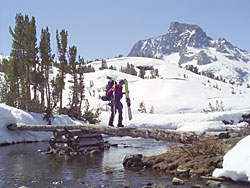
Brian Bozack just can’t get enough – Donner Summit. Photo: DSTT
Venturing into the solitude of the backcountry is a life-affirming experience. But without the proper knowledge and training, seemingly harmless mishaps or miscalculations can spiral into life threatening situations in rapid fashion. Don’t go unprepared. Reading books, such as “Allen & Mike’s Really Cool Backcountry Ski Book” (see review in this issue) or NASTC’s “All Mountain Tactics,” provides a good background on safe backcountry travel, equipment, avalanche awareness and rescue, snow camping and survival. But nothing can replace the practical experience and skill development you get from taking courses through one of these northern California guiding and instructional programs:
Alpine Skills
International
(530) 582-9170
Started 25 years ago by Bela and Mimi Vadasz, ASI helped create the template for backcountry education in California and beyond. Based in Truckee, ASI offers a complete and lengthy menu of courses for telemark, randonee and extreme skiing; plus ski mountaineering, avalanche skills, mid-winter mountaineering and ice climbing. They also offer guided trips from the Sierra High Route to the European Haute Route, plus steep skiing camps in the Eastern Sierra and on Mt. Shasta. ASI does it all.
Mountain Adventure Seminars
(209) 753-6556
Based in low-stress Bear Valley in the central Sierra, an easy drive from the Bay Area, Mountain Adventure Seminars provides a wealth of winter adventure training. Run by guides Aaron and Kimi Johnston, MAS specializes in telemark skiing and avalanche education, plus backcountry skiing, snowboarding and snowshoeing. This winter, MAS will also offer lift-access backcountry ski and snowboard courses at Bear Valley Mountain Resort. MAS will also host the 9th Annual Bear Valley Telemark Festival, February 11-13,
which has grown to become one of the premiere free-heel celebrations in the country. Register early, as it usually sells out.
North American Ski Training Center (NASTC)
(530) 582 -4772
Based in Tahoe, NASTC is a high-performance ski school for resort and out-of-bounds skiers that offers clinics and guided trips around the world… from Squaw to Jackson Hole, Chamonix to Portillo, Chile. All NASTC
trainers are members of the Professional Ski Instructors of America (PSIA) or American Mountain Guides Association (AMGA). NASTC offers backcountry and avalanche skills training in Tahoe and elsewhere in the Sierra. Courses/trips include: Introduction to Backcountry Skiing Skills (Tahoe), Overnight Ski Mountaineering Adventure (based out of Tioga Pass Resort, Eastern Sierra); and a spring climb of Mt. Shasta.
Sierra Wilderness Seminars
(888) SWS-MTNS
SWS is one of the only companies permitted to operate year-round on both Mt. Shasta and Mount Whitney. Boasting nearly a quarter century worth of instruction in backcountry, SWS offers everything from randonee and telemark lessons to “a selection of classic ski tours through some of the finest alpine wilderness terrain in the United States.” All guides are AMGA and Wilderness Instructors and Guides Association (WIGA) certified.
Outback Adventures
(408) 551-0588
A growing Bay Area retail, rental and guiding outfit, Outback Adventures offers courses in introductory snow camping (Lassen National Park), backcountry snowriding (skiing or boarding, Lassen), and single- and multi-day mountaineering courses (Shasta or Lassen).

